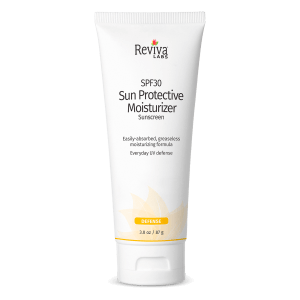Skin Care
What are you doing to your skin if you’re not wearing sunscreen every day?
You're probably sick of hearing about sunscreen. Anyone who knows anything about skin care will tell you that protecting your skin from the sun is one of the most important – if not THE most important thing you can do to keep your skin looking youthful and healthy.
Why is sun protection so important?
Tanned skin is often held up as a standard of beauty. Think of the ads you see of men and women frolicking on the beach – there’s seldom a pale body among them. But what many don’t realize, or simply choose to ignore, is that tanned skin is damaged skin. The actual tanned/darkened skin is a sign of skin damage.
And while some may feel it’s OK to tan once in a while for a special event, what’s important to remember is that the sun’s damage to the skin is cumulative. So, even if you only got sunburned once in your life, and maybe have only been tan once or twice – and it was years ago – the damage to your skin can’t be undone.
Even if you don't tan or burn, your skin may be damaged by the sun
Maybe you've never had a tan, and you’ve been fortunate enough to never have experienced a sunburn. But, if you’re not actively protecting yourself from the sun’s UVA and UVB rays, you are still putting your skin at risk.
Even in the winter, and on overcast days when you might not see the sun, the damaging UVA and UVB rays are reaching your skin. That's why it’s important to use sunscreen every day. Yes, every single day – even on days when it may not seem that the sun can be damaging your skin.
What if I’m only out in the sun for five minutes?
It’s doubtful that five minutes in the sun will cause your skin to tan or burn. But those five minutes that your skin is exposed to UVA and UVB rays can still have a negative effect on your skin in the long run. In fact, you don't even have to be outside for sun damage to occur: if you sit next to a window in your car, or on an airplane, or even in your office or home, the sun’s rays can reach your skin and cause damage.
What does “cumulative damage” mean?
While skin is very effective at “repairing” itself by constantly replicating themselves and creating new cells, there is some damage that can’t be repaired so easily. When your skin becomes damaged from sun exposure your skin cells may mutate. That mutation may then be passed on to the new cells – and these mutations can cause changes in pigmentation, loss of skin elasticity, and even skin cancer. So while that sunburn may heal, and the tan will eventually fade, the damage to your skin cells has been done.
Be aware of changes in your skin
For many people, being reminded to use sun protection over and over again doesn’t do much good. Some still desire getting a golden tan the old fashioned way (lying on the beach and baking in the sun.) And, as a matter of fact, most of the sun damage dermatologists see is not from vacations to the beach. Most of it is the day-to-day sun exposure that most of us don’t give a second thought. So it's important, even if you don't believe you're getting a lot of sun exposure, to keep an eye on moles, dark spots, or any unusual changes in your skin. You should also see your dermatologist once a year, or any time you have concerns about your skin.
The bottom line when it comes to sun protection
You need daily protection from UVA and UVB rays. Every day, all year around. If your skin is not covered by protective clothing, then it needs to be protected with sunscreen. Not only will this reduce your risk of skin cancer, but it will help keep your skin looking healthier and more youthful.








